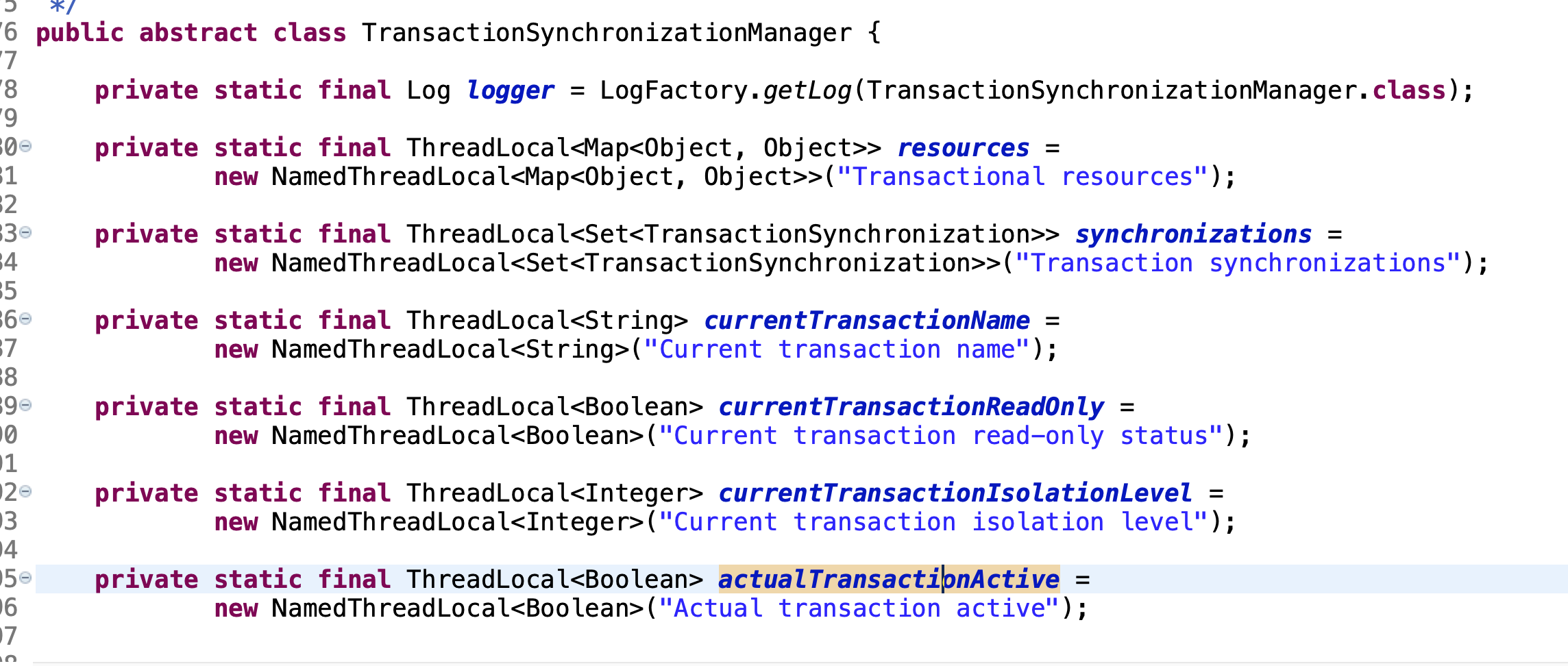查询mysql默认隔离级别,可以看到 全局和session的级别均为可重复读。


可重复读:是指在同一事务内 多次查询得到的结果是一致的。意味着在同一事务A内,多次查询的结果是一致的,不管其他事务B C D对于当前事务的操作是否提交更新,事务A中的读取结果始终一致,只有当事务A提交 当前session重新开启新事务 读到的结果才是B C D操作后的数据结果
1 import org.slf4j.LoggerFactory; 2 3 import java.sql.Connection; 4 import java.sql.DriverManager; 5 import java.sql.PreparedStatement; 6 import java.sql.SQLException; 7 8 public class LocalTranJdbcApplication { 9 10 private static final Logger LOG = LoggerFactory.getLogger(LocalTranJdbcApplication.class); 11 12 public static void main(String[] args) throws SQLException { 13 14 15 String plusAmountSQL = "UPDATE T_USER SET amount = amount + 100 WHERE username = ? "; 16 String minusAmountSQL = "UPDATE T_USER SET amount = amount - 100 WHERE username = ? "; 17 18 Connection dbConnection = getDBConnection(); 19 LOG.debug("Begin"); 20 dbConnection.setAutoCommit(false); 21 22 PreparedStatement plusAmountPS = dbConnection.prepareStatement(plusAmountSQL); 23 plusAmountPS.setString(1, "aa"); 24 plusAmountPS.executeUpdate(); 25 26 PreparedStatement minusAmountPS = dbConnection.prepareStatement(minusAmountSQL); 27 minusAmountPS.setString(1, "bb"); 28 minusAmountPS.executeUpdate(); 29 30 dbConnection.commit();//在这里打断点,并且debug启动,LocalTranJdbcApplication2 会阻塞(37行会被阻塞), 31 //因为mysql会先等到我们这个事务提交,LocalTranJdbcApplication2中的更新才会执行 32 LOG.debug("Done!"); 33 34 plusAmountPS.close(); 35 minusAmountPS.close(); 36 dbConnection.close(); 37 } 38 private static Connection getDBConnection() throws SQLException { 39 String DB_DRIVER = "com.mysql.jdbc.Driver"; 40 String DB_CONNECTION = "jdbc:mysql://localhost:3306/dist_tran_course"; 41 String DB_USER = "root"; 42 String DB_PASSWORD = "123456"; 43 try { 44 Class.forName(DB_DRIVER); 45 } catch (ClassNotFoundException e) { 46 LOG.error(e.getMessage()); 47 } 48 return DriverManager.getConnection(DB_CONNECTION, DB_USER, DB_PASSWORD); 49 } 50 }
1 import org.slf4j.Logger; 2 import org.slf4j.LoggerFactory; 3 4 import java.sql.*; 5 6 public class LocalTranJdbcApplication2 { 7 8 private static final Logger LOG = LoggerFactory.getLogger(LocalTranJdbcApplication2.class); 9 10 public static void main(String[] args) throws SQLException { 11 12 // String sql = "SELECT * FROM T_USER Where id =1 FOR UPDATE"; 13 //在里面的FOR UPDATE的意思是将获取的结果加锁,打开这条语句的时候,程序将会阻塞在第23行 14 //既然要加锁,那么首先得获取锁(也就意味着需要等到其他操作这条数据事务线程提交(释放锁)),另外使用FOR UPDATE的时候, 15 //一般锁需要对查询结果加限制条件 比如上面的id=1,不然容易锁全表,加限制条件 少量结果行 16 String sql = "SELECT * FROM T_USER "; 17 String plusAmountSQL = "UPDATE T_USER SET amount = ? WHERE username = ?"; 18 19 Connection dbConnection = getDBConnection(); 20 LOG.debug("Begin session2"); 21 22 PreparedStatement queryPS = dbConnection.prepareStatement(sql); 23 ResultSet rs = queryPS.executeQuery(); 24 Long superManAmount = 0L; 25 while (rs.next()) { 26 String name = rs.getString(2); 27 Long amount = rs.getLong(3); 28 LOG.info("{} has amount:{}", name, amount); 29 if (name.equals("aa")) { 30 superManAmount = amount; 31 } 32 } 33 34 PreparedStatement updatePS = dbConnection.prepareStatement(plusAmountSQL); 35 updatePS.setLong(1, superManAmount + 100); 36 updatePS.setString(2, "aa"); 37 updatePS.executeUpdate(); 38 39 LOG.debug("Done session2!"); 40 queryPS.close(); 41 updatePS.close(); 42 dbConnection.close(); 43 } 44 45 private static Connection getDBConnection() throws SQLException { 46 String DB_DRIVER = "com.mysql.jdbc.Driver"; 47 String DB_CONNECTION = "jdbc:mysql://localhost:3306/dist_tran_course"; 48 String DB_USER = "root"; 49 String DB_PASSWORD = "123456"; 50 try { 51 Class.forName(DB_DRIVER); 52 } catch (ClassNotFoundException e) { 53 LOG.error(e.getMessage()); 54 } 55 return DriverManager.getConnection(DB_CONNECTION, DB_USER, DB_PASSWORD); 56 } 57 }
ThreadLocal在bean的管理中的使用
当运行于多线程环境下的某个对象使用ThreadLocal维护变量时,ThreadLocal为每个使用该变量的线程独立分配一个变量副本,每个线程都使用自己的变量副本,从而不影响其他其他线程。
public class SequenNumber {
private static ThreadLocal<Integer> seqNum = new ThreadLocal<Integer>() {
public Integer initialValue() {
return 0;
}
};
public int getNextNum() {
seqNum.set(seqNum.get()+1);
return seqNum.get();
}
public static void main(String[] args) {
SequenNumber sn = new SequenNumber();
TestClient t1 = new TestClient(sn);
TestClient t2 = new TestClient(sn);
TestClient t3 = new TestClient(sn);
t1.start();
t2.start();
t3.start();
}
private static class TestClient extends Thread {
private SequenNumber sn;
public TestClient(SequenNumber sn) {
super();
this.sn = sn;
}
@Override
public void run() {
System.out.println(sn.hashCode());
for(int i=0;i<3;i++) {
System.out.println(Thread.currentThread().getName()+"---"+sn.getNextNum());
}
}
}
}
1304030204
1304030204
1304030204
Thread-0---1
Thread-1---1
Thread-0---2
Thread-2---1
Thread-0---3
Thread-1---2
Thread-1---3
Thread-2---2
Thread-2---3
结果里面可以看出,每个线程都共享一个SequenNumber对象,但是实际上他们没有相互干扰,各自产生自己的序列号,因为ThreadLocal为每个线程提供一个单独的副本。
一般来说,只有无状态bean才能在多线程环境下被设计为单例的,但是spring里面的bean绝大部分是单例的, 然而这些bean并不是无状态的,spring使用ThreadLocal对这些无状态的bean进行封装,让他们能以单例在多线程环境下运行。例如 web应用中 划分为三层 Controller Service Dao,一般来说从接受请求到返回响应的所有经过过程调用均是同一线程,这样用户就可以根据需要,将一些非线程安全的变量以ThreadLocal存放,在同一请求响应过程中,所有对象访问的是同一ThreadLocal变量所绑定的。下面演示这一思路。
import java.sql.Connection;
import java.sql.DriverManager;
import java.sql.SQLException;
import java.sql.Statement;
public class TestDao {
private static ThreadLocal<Connection> connThreadLocal = new ThreadLocal<>();
public static Connection getConnection() {
Connection conn = connThreadLocal.get();
if(conn==null) {
try {
conn = DriverManager.getConnection("自己的数据库配置");
} catch (SQLException e) {
e.printStackTrace();
}
connThreadLocal.set(conn);
}
return conn;
}
public void addData() throws Exception{
Statement statement =getConnection().createStatement();
//执行数据库操作
}
}
不同的请求对应的线程在使用TestDao时先通过ThreadLocal对象判断当前线程是否持有Connection对象,如果没有那么创建一个 并且将其设置到ThreadLocal中,如果不为null,说明当前线程已经拥有Connection对象 可以直接使用,这样就可以保证不同的线程使用自己独立的Connection对象,而不会使用其他线程的Connection对象,此时 TestDao就可以被设置为单例的了。当然 这个例子是比较粗糙的 只能实现TestDao的多个方法共享一个Connection对象,无法实现其他dao也共同使用一个Connection对象,,要做到这一点需要在一个外部的共同类使用ThreadLocal保存Connection对象,这个例子只是说明一下spring改造bean的思路。

spring 通过TransactionSynchronizationManager将Dao Service中影响线程安全的所有状态(资源,事务名,事务状态,隔离级别,事务激活状态等等)统一抽取到这个类中,因此Dao和Service可以摘掉非线程安全的帽子 使用单例来运行。
事务的传播行为,事务传播是spring事务管理的重要概念 重要不言而喻。

spring中默认的事务传播行为时PROPAGATION_REQUIRED,当多个事务方法嵌套调用时,那么这些事务方法就工作在同一事务环境下,后面的事务方法会加入到前面的事务环境下,也就是说 能统一回滚。
基于jdk事务增强的方法必须是 public修饰的并且不能是 public static修饰的
基于CGlib的事务增强的方法不能是private ,static,final 修饰的。
上面两类不能增强的情况是指这些方法不能启动事务,并不是说这些方法就不能运行在事务环境下,当存在方法嵌套时,如果这些方法嵌套外层是事务环境,那么根据spring传播机制,这些方法也能运行在事务环境下。